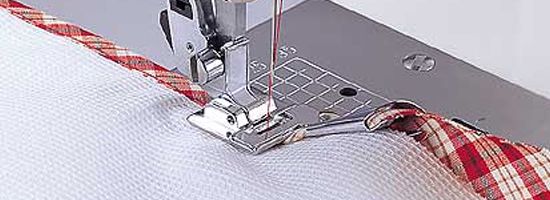While the idea of using bias fold tape can be a bit intimidating, the benefits of learning how to incorporate it into your sewing projects will soon well outweigh all you fears. Narrow strips of material that have been cut on the bias or cross grain of a length of fabric (at a 45° angle from the vertical or horizontal threads) and sewn together for an even longer length become what is called bias tape. At the store, you can purchase flat, single folded and double fold bias tape in a variety of colors and widths. You can even learn how to make bias trim to match your own custom projects.

1. Applying bias tape to uneven edges and seam allowances is called a Hong Kong Finish. It can make all the difference between a tell-tale “handmade” piece of clothing and a professionally finished one. Unlined jackets, blouses, dresses and skirts will have that high quality look when you add this nice finishing touch. Simply stitch one side of the binding tape to the open side of seam allowance or unfinished edge with a 1/4 inch seam. Fold the bias tape over the edge and slightly over the original line of stitching. Stitch “in the ditch” or hand sew on wrong side. Repeat for other edges.
2. Sewing bias tape on custom crafts such as hand bags, lap top cases, jewelry totes, glasses and cell phone cases, and book and binder covers will allow you to add finished pockets and decorative trims. Home accessories such as tea coasters, pot holders or kitchen mitts can also benefit from binding the edges neatly.
3. Every quilt needs to have its edges properly finished. By learning how to make your own sewing bias tape you can vary the width to suit each individual design. Making nicely mitered corners is not nearly as difficult as it looks, and the results will be a finished heirloom you can be truly proud of. Double bias tape is more durable for baby blankets and quilts that will be washed frequently.
4. A bias tape maker can speed up the process of creating your own bias strips, especially for projects that require longer lengths. This little gadget allows you to feed in your bias strip fabric in one end and pull it out the other, folded and ready to be ironed in place.
5. Another useful tool is a bias binder foot. This attachment replaces your presser foot and then can be used to apply bias tape, either your own or packaged, directly to the edge of your fabric in one easy step. The pre-folded tape can be attached with a straight, zigzag or decorative stitch according to the needs of your project.
6. Consider specialty bias binding tapes for unique fabric materials such as vinyl, sweat bands, bengaline, latex-free elastic, heavy twill and cotton Supraduck. These alternatives allow you to expand your sewing options to automotive, sporting goods such as duffle bags, sportswear, furniture and luggage. You can even create safety gear, medical kit bags and carpet bindings. The possibilities are only limited by the ability of your sewing machine to handle different weights and textures and your imagination.
7. For long stretches of straight line binding such as quilt sides, straight cut strips can be substituted for bias binding tapes. This will save you extra fabric and time. Because there are no curves, a less flexible binding works fine.
8. You can save time and fuss on those small curved necklines and arm holes on children’s clothing by adding matching or contrasting bias binding. The tape will conform easily to the shape of the curve and leave a clean, finished look in much less time than a facing would require. There will also be no problem with the facing material ever sticking out or needing additional pressing to wear.
9. Projects such as Christmas stockings can look really festive when the facing is turned outwards and the edges are bound with decorative binding tape. Not every facing should be hidden, especially if the colors and fabrics have been nicely coordinated. How about braiding your binding tape into a cheery, durable holiday rug or interweaving it for a decorative, custom look?
10. Using bias tape is a great way to stabilize knit fabrics. Many sewers tend to avoid knits because they are nervous about finishing the edges neatly. Just think of all the tops you can whip up with this quick edging application. If your sewing machine has a stretch stitch, you are ready to go.
Bias binding tape is a handy sewing notion for the home seamstress and/or craft person. Adding color or contrast and a professionally finished look to your project can be easy and inexpensive. After a few successes, you’ll wonder how you ever survived without it!








